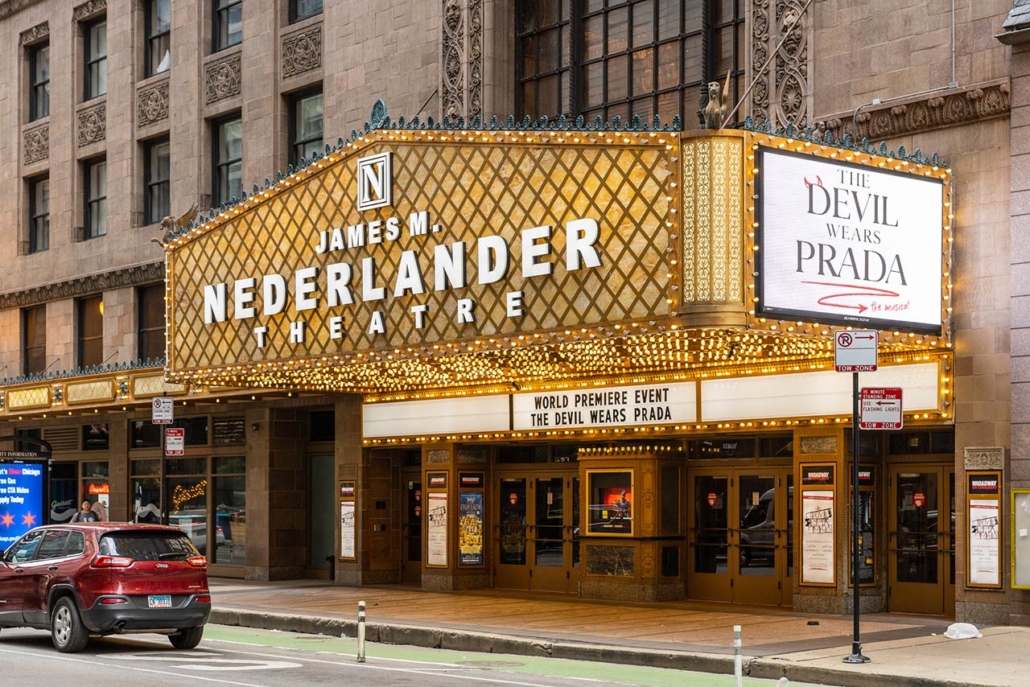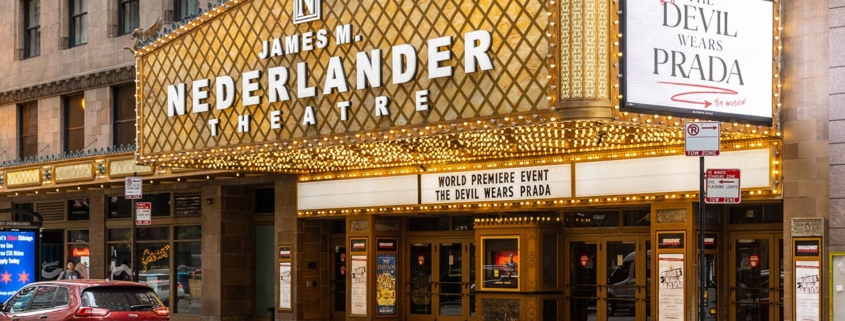Neighborhood News: A Haunting Legacy at the Loop’s James M. Nederlander Theatre

The James M. Nederlander Theatre, 24 West Randolph Street, stands on the shoulders of the two theatres that preceded the Nederlander at that spot. And rumor has it…the ghost of one predecessor haunts the theatre to this day.
In recognition of both Halloween and Fire Safety Month, it seems appropriate to mention the history of the Nederlander, which recently made Condé Nast’s list of the “42 Most Haunted Places in the World. The Nederlander, according to Secret Chicago, sits at number 12 on the list, just after The Forbidden City in Beijing, China. Most of the local ghost tours take you to this spot for its long, storied history.
Currently, the home of the touring company of ‘Hamilton’ through December 30, this ornate theatre opened November 23, 1903 as theIroquois Theatre. It was hailed as being fireproof.
A Haunting We Will Go…
If the name sounds familiar, the Iroquois Theatre was the ‘fire-proof’ building that became the site of the deadliest single-building fire in U.S. history. As Smithsonian Magazine recounts it, there were more than 1700 people in the theatre that day, 600+ standing room…mostly women and children enjoying winter break. According to the magazine, “During a performance of the comedy-musical ‘Mr. Bluebeard,’ on December 30, 1903, as the show began its second act at 3:15 that afternoon, a spark from a stage light ignited nearby drapery. “Attempts to stamp out the fire with a primitive retardant did nothing to halt its spread across the flammable decorative backdrops” recalled The Smithsonian Magazine. “Chicago native and actor Eddie Foy, dressed in drag for his next scene, attempted to calm the increasingly agitated audience. He ordered the orchestra to continue playing as stagehands made futile attempts to lower a supposedly flame-retardant curtain, but it snagged.”
Windy City Ghosts picks up the narrative. “People were rushing out of the seats. This did not do much good though because they could not easily find any exits. The exits of the theatre were not labeled. Plus, the doors had used what is known as a bascule lock. These locks are popular in theatres in Europe but not in Chicago. The people could not figure out how to unlock the doors to escape.”
As a result, hundreds of people were trampled, then burned in the commotion. Others lost their lives when they jumped off the fire escapes off the upper gallery.
Tragedy spurs change
Just as other fires inspired safety changes, the Iroquois fire prompted widespread implementation of safety features that we take for granted today, according to Wikipedia sources. These include the panic bar, asbestos fire curtains, and doors that open outward. The exterior of the Iroquois was intact, so the theater was rebuilt, renamed and reopened as the Hyde & Behman’s Music Hall in September 1904. In October 1905, it was rechristened as the Colonial Theatre. It remained active until the building was demolished in 1925, and the new Oriental Theater began operating. The Oriental Theater operated, in various forms, until 2019, when the Nederlander Organization took over the building through its Broadway in Chicago connection.
Death Alley and its legacy
The fire’s recorded death toll reached 602. Legend has it, according to Choose Chicago, that it took more than five hours to retrieve the bodies, and the alley behind the theatre, known now as Couch Place, functioned as a temporary morgue. Today, Choose Chicago says, “reports of faint cries, apparitions, and feelings of being touched or even pushed by invisible entities have been reported in that same spot — hence the nickname “Death Alley.” Also, the Chicago Loop Alliance reports If you travel down this alley, pay attention: You could experience a cold breeze over your shoulder or hear whispers of your name called by those who died in the fire.
Other Ghostly Images
According to American Ghost Walks,paranormal activity related to the fire continues to this day. Apparitions have been observed plunging to their deaths. Fire has been observed bursting outside the back of the theater. The smell of smoke is not an uncommon occurrence. But according to iHeartRadio blog, of its spirited sightings, “the most well-known ghost is the Woman in White, a spectral figure said to appear in the balcony area, dressed in white attire. She is often spotted watching performances from the back rows before disappearing. Nederlander Theatre’s legacy as a cultural gem is matched only by its mystifying tales, offering theater enthusiasts and those curious about the metaphysical a chance to experience history that extends beyond the footlights.”
Alison Moran-Powers and Dean’s Team Chicago



